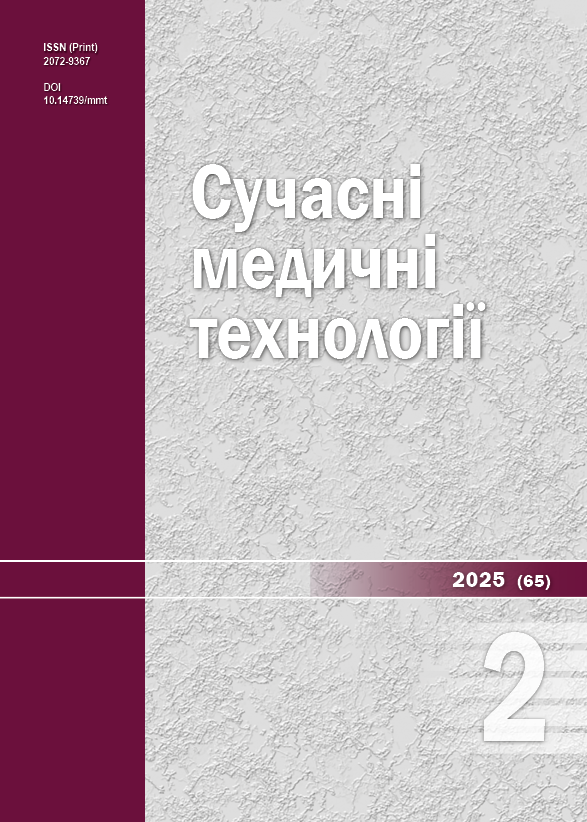Peculiarities of the composition of surface and groundwater in eastern Ukraine during the war: assessment of environmental and carcinogenic risks
DOI:
https://doi.org/10.14739/mmt.2025.2.328977Keywords:
assessment of environmental and carcinogenic risks, composition of surface and ground waters, water quality, Ukraine, military operationsAbstract
Russia’s war against Ukraine has devastating humanitarian, social, economic and environmental consequences. To assess them, it is important to monitor environmental pollutants in the eastern regions of Ukraine. This study analyses the chemical composition of surface and groundwater near the frontline in Zaporizhzhia region and justifies the need to develop a state plan for the restoration of damaged areas.
Aim. To study the content of environmental toxins, organic compounds and heavy metals in surface and ground waters in the south-east of Ukraine near the frontline and to identify areas of high risk of pollution.
Materials and methods. During the period of 2024, 70 drinking water samples were collected and examined from the centralised water supply networks of the city of Zaporizhzhia of the Municipal Enterprise “Vodokanal” and Enterprise of State Criminal-Executive Service of Ukraine. Groundwater samples were taken by professional hydrogeologists on November 9, 2024, near Tarasivka village (geographical coordinates: 47°46′41′′N 35°26′36′′E / 47.77806°N 35.44333°E) and near Vilne village (geographical coordinates: 47.57286°N 32.61995°E) of Komyshuvakha village, Orikhiv district, Zaporizhzhia region, at a depth of 5, 14 and 190 meters. The water was not preserved and was delivered to the laboratory within a few hours. The chemical analysis was carried out in the laboratory of Ukrkhimanaliz LLC of the Center for Preventive Medicine of the State Administration of Affairs. The presence of heavy metals and organic compounds (50 indicators in total) was studied by atomic emission spectral, photometric, titrimetric, ionometric, colorimetric, chromatographic and calculation methods.
Results. Analysis of 70 samples of drinking water in Zaporizhzhia from the centralised water supply networks of the Municipal Enterprise “Vodokanal” and Enterprise of State Criminal-Executive Service of Ukraine showed that 67–96 % did not meet hygiene standards for trihalogen methanes. Chemical analysis of groundwater showed significant contamination of aquifers at the 5- and 14-meter levels near the frontline due to a significant increase in nitrate and aluminium content. The groundwater was characterized by high levels of salts, sulphates, calcium and magnesium. Such groundwater quality indicators may be related both to the natural features of the area, namely the chemical composition of the soil, and man-made factors caused by the hostilities. The high mineralisation and hardness of the water, and the excessive content of nitrates and heavy metals (aluminium) made the water unsuitable for drinking purposes. At a depth of 190 meters (interstitial water – artesian water), no chemical pollutants were detected, and the organoleptic, sanitary and toxicological indicators met the sanitary and hygienic requirements according to State Sanitary Rules and Norms 2.2.4-171-10 “Hygienic Requirements for Drinking Water Intended for Human Consumption”.
Conclusions. Drinking water from centralised water supply networks in Zaporizhzhia in 67–96 % of cases does not meet hygiene standards for trihalogen methanes. Groundwater in Zaporizhzhia region near the frontline at a depth of 5 and 14 meters is highly mineralised, containing high concentrations of nitrates and aluminium, making it unsuitable for drinking. The artesian water in this region does not contain pollutants of man-made and military origin, which indicates that the interlayer is not damaged, and this water is suitable for drinking. High levels of salt and general hardness of groundwater are associated with the geochemical features of the area. The high nitrate content and 1.4 times higher aluminium levels are the result of soil contamination in the area.
References
War in UA. Environmental Impact. Top Lead. [cited 2025 Apr 2]. Available from: https://www.topleadprojects.com/environmental-project-main
Pereira P, Bašić F, Bogunovic I, Barcelo D. Russian-Ukrainian war impacts the total environment. Sci Total Environ. 2022;837:155865. doi: https://doi.org/10.1016/j.scitotenv.2022.155865
Racioppi F, Rutter H, Nitzan D, Borojevic A, Carr Z, Grygaski TJ, et al. The impact of war on the environment and health: implications for readiness, response, and recovery in Ukraine. Lancet. 2022;400(10356):871-3. doi: https://doi.org/10.1016/S0140-6736(22)01739-1
Shumilova O, Tockner K, Sukhodolov A, Khilchevskyi V, De Meester L, Stepanenko S, et al. Impact of the Russia-Ukraine armed conflict on water resources and water infrastructure. Nat Sustain. 2023;6(5):578-86. doi: https://doi.org/10.1038/s41893-023-01068-x
Rawtani D, Gupta G, Khatri N, Rao PK, Hussain CM. Environmental damages due to war in Ukraine: A perspective. Sci Total Environ. 2022;850:157932. doi: https://doi.org/10.1016/j.scitotenv.2022.157932
Prodanchuk M. Toxicological aspects of war and warfare: the war in Ukraine. In: 43rd Congress of the European Association of Poison Centres and Clinical Toxicologists. 2023 May 23-26.
Antonenko V, Matyukha V, Sukhina O, Ulytskyi O. Compensation for damage to ecosystems of Ukraine as a consequence of armed aggression by the russian side. In: The level of development of science and technology in the XXI century: Innovative technology, Architecture, Medicine, Biology, Geology. 2022;(sge14-02):67-81. doi: https://doi.org/10.30890/2709-2313.2022-14-02-015
Carpenter SR, Stanley EH, Vander Zanden MJ. State of the world’s freshwater ecosystems: Physical, chemical, and biological changes. Annu Rev Environ Resour. 2011;36(1):75-99. doi: https://doi.org/10.1146/annurev-environ-021810-094524
Gleick PH. Water as a weapon and casualty of conflict: Freshwater and international humanitarian law. Water Resour Manage. 2019;33(5):1737-51. doi: https://doi.org/10.1007/s11269-019-02212-z
Schillinger J, Özerol G, Güven-Griemert Ş, Heldeweg M. Water in war: Understanding the impacts of armed conflict on water resources and their management. WIREs Water. 2020;7(6):e1480. doi: https://doi.org/10.1002/wat2.1480
Zheleznyak M, Donchyts G, Maderich V, Dronova I, Tkalich P, Trybushnyi D, et al. Ecological footprint of Russia's Ukraine invasion. Science. 2022;377(6612):1273. doi: https://doi.org/10.1126/science.ade6869
Klinkenberg A. The radioactive threat to Ukraine’s groundwater [Internet]. FairPlanet. [cited 2025 Apr 3]. Available from: https://www.fairplanet.org/editors-pick/the-radioactive-threat-to-ukraines-groundwater/
Koban LA, Pfluger AR. Per- and polyfluoroalkyl substances (PFAS) exposure through munitions in the Russia-Ukraine conflict. Integr Environ Assess Manag. 2023;19(2):376-81. doi: https://doi.org/10.1002/ieam.4672
Hryhorczuk D, Levy BS, Prodanchuk M, Kravchuk O, Bubalo N, Hryhorczuk A, et al. The environmental health impacts of Russia's war on Ukraine. J Occup Med Toxicol. 2024;19(1):1. doi: https://doi.org/10.1186/s12995-023-00398-y
Boychenko SV, Chernyak LM, Radomska MM, Bondaruk AV. [The problem of cleaning natural water bodies polluted by wastewater from oil product supply facilities]. Science-based technologies. 2015;(4):353-7. Ukrainian.
Bolt HM, Degen GH, Dorn SB, Plöttner S, Harth V. Genotoxicity and potential carcinogenicity of 2,4,6-TNT trinitrotoluene: structural and toxicological considerations. Rev Environ Health. 2006;21(4):217-28. doi: https://doi.org/10.1515/reveh.2006.21.4.217
PubChem [Internet]. Bethesda (MD): National Library of Medicine (US), National Center for Biotechnology Information; 2004-. PubChem Compound Summary for CID 8376, Trinitrotoluene; [cited 2025 Apr 3]. Available from: https://pubchem.ncbi.nlm.nih.gov/compound/Trinitrotoluene
Wei T, Zhou Y, Yang ZL, Yang H. Progress of toxicity effects and mechanisms of typical explosives. Chinese journal of energetic materials. 2019;27:558-68. doi: https://doi.org/10.11943/CJEM2019068
The toxic legacy of the Ukraine war [Internet]. UNEP. United Nations Environment Programme; 2023 [cited 2025 Apr 3]. Available from: https://www.unep.org/news-and-stories/story/toxic-legacy-ukraine-war
New coordination center to assess environmental impacts of the war on Ukraine | United Nations Development Programme [Internet]. UNDP; 2023. Available from: https://www.undp.org/ukraine/press-releases/new-coordination-center-assess-environmental-impacts-war-ukraine
Ukraine: Thousands of children lack safe drinking water as Kakhovka Dam crisis unravels [Internet]. ReliefWeb; 2023 [cited 2025 Apr 3]. Available from: https://reliefweb.int/report/ukraine/ukraine-thousands-children-lack-safe-drinking-water-kakhovka-dam-crisis-unravels
Ukraine conflict environmental briefing: The coastal and marine environment [Internet]. CEOBS. The Conflict and Environment Observatory; 2023 [cited 2025 Apr 3]. Available from: https://ceobs.org/ukraine-conflict-environmental-briefing-the-coastal-and-marine-environment
Zhang C, Hu Q, Su W, Xing C, Liu C. Satellite spectroscopy reveals the atmospheric consequences of the 2022 Russia-Ukraine war. Sci Total Environ. 2023;869:161759. doi: https://doi.org/10.1016/j.scitotenv.2023.161759
Canals in Ukraine are drying up. 2023 [cited 2025 Apr 3]. Available from: https://earthobservatory.nasa.gov/images/151622/canals-in-ukraine-are-drying-up
Shevchuk S, Vyshnevskyi V, Bilous O. The Use of Remote Sensing Data for Investigation of Environmental Consequences of Russia-Ukraine War. Journal of Landscape Ecology. Sciendo. 2022;15(3):36-53. doi: https://doi.org/10.2478/jlecol-2022-0017
Wenning RJ, Tomasi TD. Using US Natural Resource Damage Assessment to understand the environmental consequences of the war in Ukraine. Integr Environ Assess Manag. 2023;19(2):366-75. doi: https://doi.org/10.1002/ieam.4716
Zaliska O, Oleshchuk O, Forman R, Mossialos E. Health impacts of the Russian invasion in Ukraine: need for global health action. Lancet. 2022;399(10334):1450-2. doi: https://doi.org/10.1016/S0140-6736(22)00615-8
Brown S. Landmines and explosive remnants of war in Ukraine will take decades to clear [Internet]. Kyiv Post; 2023 [cited 2025 Apr 3]. Available from: https://www.kyivpost.com/post/14439
Ward MH, Jones RR, Brender JD, de Kok TM, Weyer PJ, Nolan BT, et al. Drinking Water Nitrate and Human Health: An Updated Review. Int J Environ Res Public Health. 2018;15(7):1557. doi: https://doi.org/10.3390/ijerph15071557
Zhu X, Hao W, Liu Z, Song Y, Hao C, Wu S, et al. Aluminum induces neuroinflammation via P2X7 receptor activating NLRP3 inflammasome pathway. Ecotoxicol Environ Saf. 2023;249:114373. doi: https://doi.org/10.1016/j.ecoenv.2022.114373
Rawtani D, Gupta G, Khatri N, Rao PK, Hussain CM. Environmental damages due to war in Ukraine: A perspective. Sci Total Environ. 2022;850:157932. doi: https://doi.org/10.1016/j.scitotenv.2022.157932
Zhou J, Anthony I. Environmental accountability, justice and reconstruction in the Russian war on Ukraine [Internet]. SIPRI; 2023 Jan 25 [cited 2025 Apr 3]. Available from: https://www.sipri.org/commentary/topical-backgrounder/2023/environmental-accountability-justice-and-reconstruction-russian-war-ukraine
Abdullah H. Ukraine needs a "green Marshall plan" that empowers cities and civil society [Internet]. GMFUS; 2023 [cited 2025 Apr 3]. Available from: https://www.gmfus.org/news/ukraine-needs-green-marshall-plan-empowers-cities-and-civil-society
Downloads
Additional Files
Published
How to Cite
Issue
Section
License
Copyright (c) 2025 O. O. Kovalov, Yu. М. Kolesnyk, А. І. Sevalniev, О. V. Hancheva, L. P. Sharavara, К. О. Kovalov, Т. М. Tyshchenko, Ye. О. Tulushev

This work is licensed under a Creative Commons Attribution-NonCommercial 4.0 International License.
The work is provided under the terms of the Public Offer and of Creative Commons Attribution-NonCommercial 4.0 International (CC BY-NC 4.0). This license allows an unlimited number of persons to reproduce and share the Licensed Material in all media and formats. Any use of the Licensed Material shall contain an identification of its Creator(s) and must be for non-commercial purposes only.














